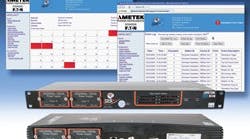When an alarm sequence occurs in a process plant, things happen pretty fast. Operators need to see quickly and clearly what's going on so they can act accordingly. "The more complicated the processes get, the more you're apt to see things happening quickly," says Steve Bleier, product manager at Ametek Power Instruments. "Operators need to differentiate one alarm from another."
Ametek's new SERNET advanced alarm management system provides this vital information in near-real time and makes it accessable across a facility. Bleier says SERNET is the only system that provides nearly instant, secure, networked, browser-based alarm management capability all in one package.
The browser functionality simplifies sorting out exactly what is happening. It offers separate screens for displaying alarms and archived events.
"In an alarm condition, operators need to be able to see what's going on—both active alarms and alarms in the order in which they occur," explains Bleier. "The browser becomes the HMI for what is occurring. That gives the operators a heads up as to order of events. We have a couple of types of browser windows. One is just a graphic window that gives a quick overview. Then there's the active alarm log that shows the date and time and descriptor for the event for processing alarms as they occur."
Each SERNET can work as a standalone system, monitoring up to 48 digital inputs, or multiple units can be networked together to form a larger system with all events consolidated in one chronological list as they occur.
"We offer two different ways of networking," explains Bleier. "Individual units are networked on the LAN for remote monitoring and multiple units can be networked together to form one system with a single web browser displaying all alarms in the order in which they occur."
This flexibility makes it easy to analyze alarms across an entire site or even across multiple sites for a larger system view—a much better approach than piecing together a list of alarms from multiple devices. It also gives users the ability to monitor their facilities remotely. This eliminates the need to wire everything to a central location.
"You don't have to be in the control room to see the alarms," says Bleier. "Anyone with access to the secure network can see the alarms from wherever they are."
Bleier goes on to explain that all the units can be synchronized to the same clock using either IRIG-B or Networking Time Protocol (NTP).
The SERNET web browser includes sorting and filtering functions to help with the root-cause analysis. In addition to displaying alarms, the web browser is also used for all configuration details and downloading of events via CSV or ComTrade formats.
The SERNET recorder can transmit alarms as they occur with Modbus, DNP, ASCII and BACnet protocols. Various devices, including DCSs and PLCs can receive the alarms. Email notification of critical alarms can be provided along with SNMP for network management.
Each SERNET unit can store 40,000 events in memory for long-term data storage, and the unit can be supplied with a single- or dual-redundant, hot-swappable power supply for added reliability.
For more information, go to www.ametekpower.com or call 978/988-4903.




